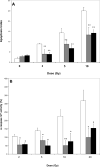Novel synthetic SOD/catalase mimetics can mitigate capillary endothelial cell apoptosis caused by ionizing radiation
- PMID: 20518654
- PMCID: PMC4405254
- DOI: 10.1667/RR1948.1
Novel synthetic SOD/catalase mimetics can mitigate capillary endothelial cell apoptosis caused by ionizing radiation
Abstract
Numerous in vitro and in vivo studies have shown that the endothelial cells of the microvasculature of the lung and kidney are damaged by exposure to ionizing radiation, and this sustained endothelial cell injury is involved in the early and late radiation effects observed in these tissues. It is well accepted that ionizing radiation causes the generation of reactive oxygen species during exposure that results in damage to DNA and cellular organelles. It is more controversial, however, whether additional biochemical events or long-lived radicals occur and persist postirradiation that amplify and initiate new forms of cellular damage. Two families of Eukarion (EUK) compounds have been synthesized that possess superoxide dismutase (SOD), catalase and peroxidase activities. The Mn porphyrins are available orally whereas the salen Mn complexes are administered by injection. In the present study we have examined the ability of these SOD/catalase mimetics to prevent apoptosis of endothelial cells when administered 1 h postirradiation (mitigation). A range of salen Mn complex (EUK-189 and EUK-207) and Mn porphyrins (EUK-418, -423, -425, -450, -451, -452, -453) were used to treat endothelial cells 1 h after the cells received 2-20 Gy ionizing radiation in vitro. Two lead compounds, EUK-207 at a dose of 30 microM and EUK-451 at a dose of 10 microM, exhibited low toxicity and mitigated radiation-induced apoptosis. Future animal studies will test whether these compounds protect when administered after radiation exposure as would be done after a radiological accident or a terrorism event.
Figures





References
-
- Nair CKK, Parida DK, Nomura T. Radioprotectors in radiotherapy. J Radiat Res. 2001;42:21–37. - PubMed
-
- Wyllie AH, Kerr JFR, Currie AR. Cell death: the significance of apoptosis. Int Rev Cytol. 1990;68:251–306. - PubMed
-
- Edinger AL, Thompson CB. Death by design: apoptosis, necrosis and autophagy. Curr Opin Cell Biol. 2004;16:663–669. - PubMed
Publication types
MeSH terms
Substances
Grants and funding
LinkOut - more resources
Full Text Sources

